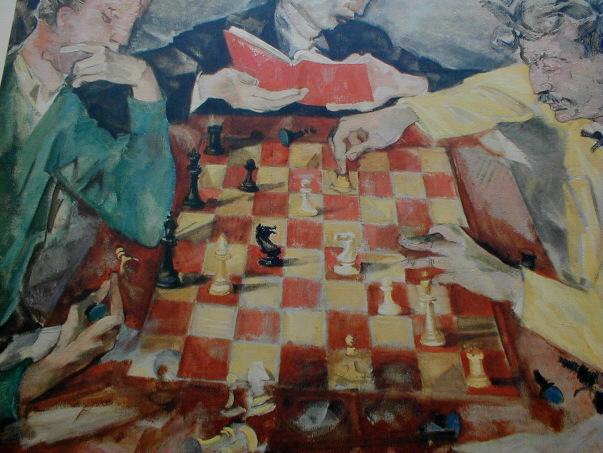On Blunderprone, the Scotch Gambit and Ct-art
Sunday, I took a ride to Manchester NH to watch some games of the New England Open which a number of my chess playing friends were taking part in. I had a pleasant lunch with Blunderprone and protegy of BP who were both playing in the tourney. Had some yucks and now the chain is somewhat extended: Transformer DK met BP who met Takchess. He played the Scotch Gambit as white and played a hard fought 4 hour plus game which ended in a drawn endgame. George, I would enjoy seeing that game posted and what computer analysis shows.
Coincidently at the same time I was playing against the Scotch Gambit in the skittles room against a fellow against in past tournaments. We were discussing the various lines in this sharp opening. I have some ideas as to how to address it a little better now that I have thought about it for a while. I find it interesting how the lines of the Goring Gambit, Danish Gambit, Four Knights, G.Piano at points transpose to each other. I think to face it I will need to play the Max Lange Lines.
I am getting into CT-ART L30 and this minicircle is starting to gell. When I do problems I often reflect on the pseudoscience that is chess improvement. One of the ongoing discussion is the appropriate level of problem difficulty. Some believe it is important to do a string of easier problem as not to lose the pattern recognition of them. I suspect that doing the difficult problems you still are using the pattern recognition of easier tactics encapsulated within. Looking at a problem you may see the elements of a Anastasia mate then its a matter of explores ways to deflect guards, open lines, interfere with protection.
My next tournament is October and I am looking forward to having good board vision and tactical play.
Update: to 573 ,175 L30 problems today Labor day Tacticthon.
Coincidently at the same time I was playing against the Scotch Gambit in the skittles room against a fellow against in past tournaments. We were discussing the various lines in this sharp opening. I have some ideas as to how to address it a little better now that I have thought about it for a while. I find it interesting how the lines of the Goring Gambit, Danish Gambit, Four Knights, G.Piano at points transpose to each other. I think to face it I will need to play the Max Lange Lines.
I am getting into CT-ART L30 and this minicircle is starting to gell. When I do problems I often reflect on the pseudoscience that is chess improvement. One of the ongoing discussion is the appropriate level of problem difficulty. Some believe it is important to do a string of easier problem as not to lose the pattern recognition of them. I suspect that doing the difficult problems you still are using the pattern recognition of easier tactics encapsulated within. Looking at a problem you may see the elements of a Anastasia mate then its a matter of explores ways to deflect guards, open lines, interfere with protection.
My next tournament is October and I am looking forward to having good board vision and tactical play.
Update: to 573 ,175 L30 problems today Labor day Tacticthon.


4 Comments:
At 10:16 AM, Blue Devil Knight said…
Blue Devil Knight said…
I vacillate between 'actively work on the simple' and your position stated here. I guess a good test is, if I pick up Bain's book and it takes me longer than 10 seconds to solve a problem, then I should work to stay 'fresh' with the basics.
I have also found that ONLY working on the simple problems blinds me to more interesting forced sequences and combinations in games. Now that I am working on more complicated sequences in CTB, I have started to look for them (and sometimes find them) in real games.
So, my hunch is that it is probably useful to do both.
At 10:17 AM, Blue Devil Knight said…
Blue Devil Knight said…
BP = bear paw.
At 12:31 PM, transformation said…
transformation said…
forgive my inclusion off topic Takchess, but time to time, i have big posts, as you do, and this one today aught not to disappoint. warmly, dk
At 10:11 AM, Jeremy Burgess said…
Jeremy Burgess said…
The Scotch Gambit remains my favourite opening as white after 2...Nc6 as I am one for slightly unsound, chaotic positions (frequently found in the Scotch) over more subdued play.
Any ideas about the line:
1.e4 e5
2.Nf3 Nc6
3.d4 exd
4.Bc4 Nf6
5.0-0 Nxe4
[6.Nxd4 d5 7.Bb5 a6 8.Nxc6 Qd7 9.Ne7 axb5 10.Nxd5]
6.Re1 d5
7.Bxd5 Qxd5
8.Nc3 Qa5
Post a Comment
<< Home